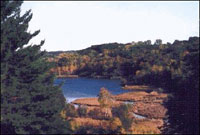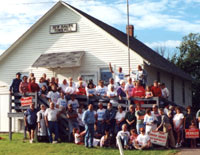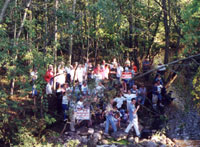Escape to Wisconsin. Play in our lakes, fish our rivers, and cavort in the famously kitschy water parks of Wisconsin Dells. Just don’t try to take a drop of it home with you.

Ninety-nine bottles of water on the wall.
This, at least, is the stern message being sent by thousands of Wisconsin citizens to Perrier, the world’s largest bottler of designer water. For the last few years Perrier has been a-dowsin’, seeking a Midwestern source for its Ice Mountain label, currently bottled in far-flung Allentown, Penn.
You might think spring water would be the ideal cash crop for rural communities. Perrier promises a potential $100 million investment and eventual employment for as many as 250 people. Bottled water is certainly not what you could call a smokestack industry; its product is widely considered wholesome. All the same, a thicket of lawn signs and bumper stickers chanting “Perrier Go Away” has blossomed across the state.
Dear Perrier … We Love You!
Ironically, the modern roots of the booming bottled-water industry can be traced to Wisconsin. In 1993, a cryptosporidium outbreak struck 403,000 Milwaukee residents, killing more than 100. Municipal water supplies — once a jewel in the crown of the nation’s public health infrastructure — have been suspect ever since. Meanwhile, per capita consumption of bottled water in the United States increased 40 percent from 1992 to 1999, with further growth expected.
While the West is accustomed to water conflict, Wisconsin is just dipping its feet into what is likely to become an ongoing battle. According to the U.S. Geological Survey, groundwater draws in Wisconsin rose a third between 1985 and 1995, reaching 750 million gallons a day. And thanks to Perrier, that pumping is no longer going unnoticed.
Perrier has had its trouble elsewhere; groups in Texas, Florida, and Maine have challenged local bottling operations. But the company’s dread Wisconsin trip actually came courtesy of state officials. Business boosters looking to liquidate some of the water wealth of the upper Midwest courted Perrier with tax breaks and airline tickets. And, like a dutiful child at Christmastime, Wisconsin’s Commerce secretary penned a cordial thank-you note to company officials.

Rights of Mecan Springs.
Photo: Friends of the Mecan.
But any idiot can find drinking water in Wisconsin; to Perrier’s dismay the real talent of state officials was finding hot water. The first site proffered by the state’s would-be water barons was just downstream from the Mecan Springs Natural Area. For years, the Wisconsin Department of Natural Resources had been safe-guarding the headwaters of the river, a trout stream of regional renown. When — despite a climate of secrecy — word leaked that the DNR was now offering Perrier a proprietary drink from this public trough, anglers and neighbors exploded. Perrier wisely backed off.
Department of Perrier
Take Two: Big Spring in Adams County. The surrounding area is picturesque — home to sandhill cranes, black crowned night herons, warbling vireos, beaver, fox, coyote, mink. There are also records of rare species and communities nearby, including the endangered northern ribbon snake and the threatened red-shouldered hawk.

New Haven’s no haven for Perrier.
Photo: Carol Zimmermann.
Almost from the outset, citizens told Perrier to take a hike, and quite officially. The New Haven town board enacted a one-year moratorium on zoning changes. Then New Haven citizens ousted a town chair — 263 votes to 92 — who supported Perrier. In the same election, they voted 290-101 against the plant, while their neighbors in Newport rejected it 114-26. Finally, the Adams County Board voted 14-3 against large-scale extraction of spring water and against the zoning changes necessary for the Perrier plant.
Perrier — perhaps taking a cue from boorish American tourists in Paris — didn’t get the hint. In late June of last year, it asked the DNR for permits to sink two wells near the headwaters of Big Spring Creek. To the amazement and outrage of local citizens, the DNR granted the permits, explaining that by the letter of state law it had no authority to regulate groundwater pumping if the pumping did not threaten a municipal water supply.
The lawsuits began. A new organization called Waterkeepers of Wisconsin sued in Adams County Circuit Court to halt the test wells. The Ho-Chunk Nation filed suit against the DNR, declaring that the springs were sacred. Their suit was joined to a similar suit filed by Concerned Citizens of Newport. Madison attorney Ed Garvey — one-time head of the NFL Players’ Union and former senatorial and gubernatorial candidate — represents the group.

Sign of the times near Big Spring Creek
aimed at then Gov. Tommy Thompson (R).
Photo: Carol Zimmermann.
“What we have is a DNR that has taken an extraordinarily narrow view of its mandate,” says Garvey. “The DNR is the trustee for our natural resources. They agree that they have this authority with respect to surface water. But they draw this false dichotomy between groundwater and surface water. I don’t think it’s much of a stretch to say that the DNR should be as concerned about groundwater as they are about surface water. Particularly when your talking about springs, because obviously the groundwater becomes surface water right there.”
“DNR has been part of Team Perrier from the beginning, helping them find the proper site” he says. “For them to then say, ‘Gosh, there’s nothing we can do to slow you down’ is disingenuous.”
The DNR did make a regulation gambit. They asked Perrier to agree that permits would be contingent on the results of extensive testing. Perrier would run the tests, and the USGS would check the company’s math.
Jane Lazgin, spokeswoman for Perrier, explains that the agreement is actually in the company’s interest. Perrier seeks geologically protected water that is “not downstream of something that could in any way imperil the water source,” she says. “As pure as it is for environmental reasons, it’s also needed in order to support a $100 million investment, to be sure this is something that will be sustainable for the long term.”
Last November, Perrier began testing, drawing 1,000 gallons a minute — twice the planned rate for the fully operational facility. DNR fish and groundwater specialists discussed halting the tests because flow on an upper tributary to Big Spring Creek had dropped by 45 percent, posing a potential threat to trout spawning beds; but the tests continued to completion.
Although the company reported almost no impact on nearly 50 distant monitoring stations, several local farmers saw their water levels drop immediately. At the time, Lazgin told local media that because of the high pumping rate, “data from the test should not be construed as a ‘trial run’ of the proposed water collection operations.” A final report on the tests is pending.
Meanwhile …

They’ve won the battle at Big Spring Creek.
Photo: Carol Zimmermann.
Last week, Wisconsin anti-Perrier activists had cause to pop the bubbly, because Perrier put Big Spring on ice. In
stead, the company announced plans to break ground on a state-of-the-art bottling facility in Michigan within the month. And, although Perrier was able to ensure the necessary local zoning, furious opposing forces have mobilized in response. Because a hearing held by the Michigan’s Department of Environmental Quality on 15 May 2001 was attended by nearly 500 people, the written comment period was extended. DEQ now does not expect to make a decision until mid- or late July.
“From day one, we needed a legal opinion,” says Terry Swier, a retired librarian from Mecosta, Mich., and president of the newly constituted Michigan Citizens for Water Conservation. She has no experience as an environmental activist, but already the MCWC has a website and a $20,000 war chest.
“This has all happened very, very quickly,” complains Swier. “In my opinion it was a done deal. [At an informational meeting,] Morton Township already had packets telling how great Perrier was, but no hard facts. Only the facts from Perrier. The township did not ask for an environmental impact statement or traffic study — nothing like that.”
There is even a bit of intrigue: When opponents of the Mecosta Township site mounted a petition drive to challenge the zoning change, lawyers for Perrier’s local boosters hired detectives to investigate signature collection. In nearby Morton Township, a clerk dismissed a similar referendum petition on a technicality: The petition referred to two ordinance changes; under Michigan law each change requires its own petition and referendum. This despite the fact that nearly 500 valid signatures were gathered — easily exceeding the 135 needed to call an election. A court has since upheld the dismissal of the referendum petition.
Though the odds would seem to be against her, Swier is unbowed. Many of her neighbors are retired and spend the winters down south. As these home-owners return to find a new corporate neighbor, local ire is on the rise. “We’ve done all this without the snowbirds,” says Swier. “The snowbirds are very upset.”
For encouragement, Swier and MCWC have only to look across Lake Michigan toward Wisconsin, where opponents continue to aggressively combat Perrier’s P.R. efforts (which the company keeps up in anticipation of the need for another Midwestern plant within a decade). As Wisconsin opponents go forward with their lawsuit, one battle appears won: The joint finance committee of the state Senate has passed a bipartisan budget amendment, 14-2, requiring a full environmental impact study of high-capacity wells for water bottlers.


